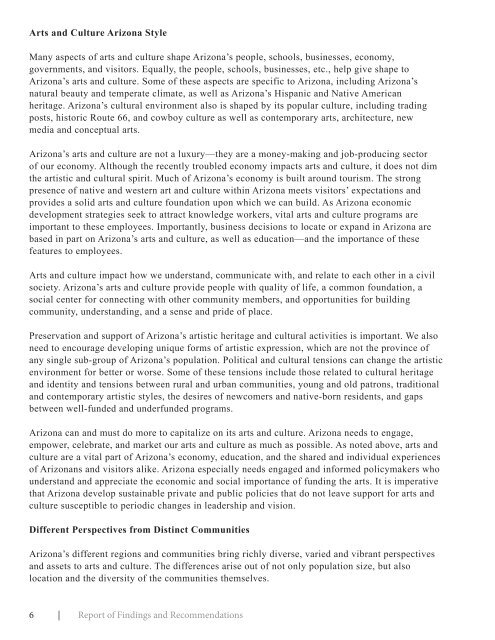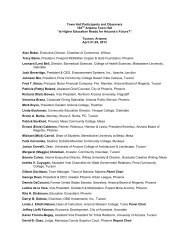Background Report - Arizona Town Hall
Background Report - Arizona Town Hall
Background Report - Arizona Town Hall
Create successful ePaper yourself
Turn your PDF publications into a flip-book with our unique Google optimized e-Paper software.
Arts and Culture <strong>Arizona</strong> Style<br />
Many aspects of arts and culture shape <strong>Arizona</strong>’s people, schools, businesses, economy,<br />
governments, and visitors. Equally, the people, schools, businesses, etc., help give shape to<br />
<strong>Arizona</strong>’s arts and culture. Some of these aspects are specific to <strong>Arizona</strong>, including <strong>Arizona</strong>’s<br />
natural beauty and temperate climate, as well as <strong>Arizona</strong>’s Hispanic and Native American<br />
heritage. <strong>Arizona</strong>’s cultural environment also is shaped by its popular culture, including trading<br />
posts, historic Route 66, and cowboy culture as well as contemporary arts, architecture, new<br />
media and conceptual arts.<br />
<strong>Arizona</strong>’s arts and culture are not a luxury—they are a money-making and job-producing sector<br />
of our economy. Although the recently troubled economy impacts arts and culture, it does not dim<br />
the artistic and cultural spirit. Much of <strong>Arizona</strong>’s economy is built around tourism. The strong<br />
presence of native and western art and culture within <strong>Arizona</strong> meets visitors’ expectations and<br />
provides a solid arts and culture foundation upon which we can build. As <strong>Arizona</strong> economic<br />
development strategies seek to attract knowledge workers, vital arts and culture programs are<br />
important to these employees. Importantly, business decisions to locate or expand in <strong>Arizona</strong> are<br />
based in part on <strong>Arizona</strong>’s arts and culture, as well as education—and the importance of these<br />
features to employees.<br />
Arts and culture impact how we understand, communicate with, and relate to each other in a civil<br />
society. <strong>Arizona</strong>’s arts and culture provide people with quality of life, a common foundation, a<br />
social center for connecting with other community members, and opportunities for building<br />
community, understanding, and a sense and pride of place.<br />
Preservation and support of <strong>Arizona</strong>’s artistic heritage and cultural activities is important. We also<br />
need to encourage developing unique forms of artistic expression, which are not the province of<br />
any single sub-group of <strong>Arizona</strong>’s population. Political and cultural tensions can change the artistic<br />
environment for better or worse. Some of these tensions include those related to cultural heritage<br />
and identity and tensions between rural and urban communities, young and old patrons, traditional<br />
and contemporary artistic styles, the desires of newcomers and native-born residents, and gaps<br />
between well-funded and underfunded programs.<br />
<strong>Arizona</strong> can and must do more to capitalize on its arts and culture. <strong>Arizona</strong> needs to engage,<br />
empower, celebrate, and market our arts and culture as much as possible. As noted above, arts and<br />
culture are a vital part of <strong>Arizona</strong>’s economy, education, and the shared and individual experiences<br />
of <strong>Arizona</strong>ns and visitors alike. <strong>Arizona</strong> especially needs engaged and informed policymakers who<br />
understand and appreciate the economic and social importance of funding the arts. It is imperative<br />
that <strong>Arizona</strong> develop sustainable private and public policies that do not leave support for arts and<br />
culture susceptible to periodic changes in leadership and vision.<br />
Different Perspectives from Distinct Communities<br />
<strong>Arizona</strong>’s different regions and communities bring richly diverse, varied and vibrant perspectives<br />
and assets to arts and culture. The differences arise out of not only population size, but also<br />
location and the diversity of the communities themselves.<br />
006 | <strong>Report</strong> of Findings and Recommendations




